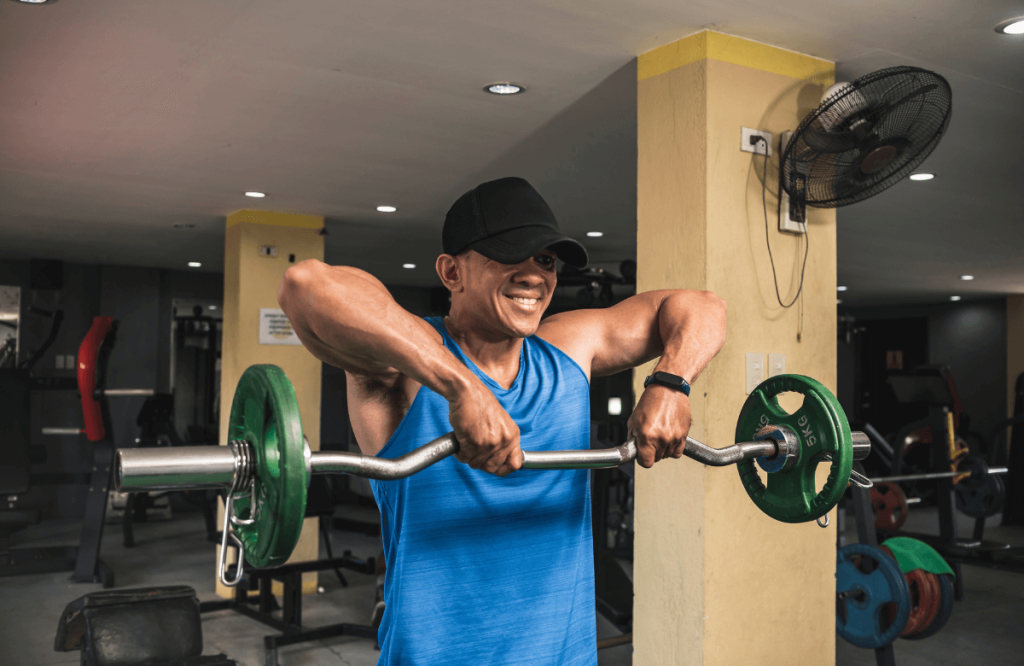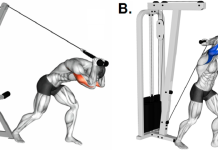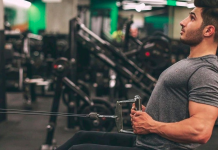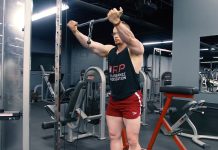Exploring the Muscles Worked in Upright Rows
If you’re serious about sculpting a strong and impressive upper body, understanding the muscles worked during various exercises is crucial. Upright rows, a popular compound movement, are no exception. In this comprehensive guide, we’ll delve into the science behind upright row muscles. By the end, you’ll have a clear picture of which muscle groups are engaged and how to perform this exercise safely and effectively.

Understanding Upright Rows
Before we dive into the specifics of which muscles are targeted, let’s take a moment to grasp the essence of the upright row exercise. This knowledge will lay the foundation for our exploration of muscle engagement.
Upright rows are a weightlifting exercise primarily designed to strengthen and develop the shoulder muscles. It involves lifting a barbell or dumbbell from a hanging position to chest height while keeping the elbows higher than the forearms. This movement effectively targets multiple muscle groups in the upper body, making it a valuable addition to your strength training routine.
Primary Muscles Targeted
Now, let’s get to the heart of the matter: the primary muscles worked during upright rows. These muscles are the powerhouses behind the exercise, and understanding their role is essential for maximizing your gains.
Deltoids Domination
Front Deltoids: The anterior deltoid muscles, located at the front of your shoulders, play a pivotal role in upright rows. They are responsible for lifting the weight as you raise your arms.
Lateral Deltoids: Situated on the sides of your shoulders, the lateral deltoids are also heavily engaged during upright rows. They assist in lifting weights and contribute to overall shoulder development.
Engaging both the front and lateral deltoids is what gives your shoulders that broad and sculpted appearance. To optimize muscle engagement in these areas, maintain proper form and execute the exercise with controlled movements.
Secondary Muscles Involved
While the deltoids take center stage in upright rows, they are not the sole performers. Several secondary muscles also come into play, contributing to the exercise’s overall effectiveness in building upper body strength and stability.
Trapezius
The trapezius, often referred to as the traps, is a large muscle that spans the neck, shoulders, and upper back. It plays a significant role in upright rows, particularly in the later stages of the movement when you lift the weight higher.
Biceps
Your biceps, the muscles in the front of your upper arms, assist in the pulling motion required during upright rows. While not the primary movers, they provide valuable support, especially when lifting heavier weights.
Upper Trapezius
Distinct from the lower trapezius, the upper traps are actively engaged as you lift the weight toward your chest. This engagement contributes to the overall development of your trapezius muscles.
Understanding the secondary muscles involved underscores the compound nature of upright rows. Not only do you target your shoulders, but you also engage muscles in your arms and upper back, promoting a balanced and well-rounded upper body.
Proper Form and Technique
To reap the full benefits of upright rows and minimize the risk of injury, it’s essential to maintain proper form and technique throughout the exercise. Here are some key points to keep in mind:
- Grip: Begin with a shoulder-width grip on the barbell or dumbbells. Adjust your grip width as needed to ensure comfort and prevent excessive strain on your wrists and shoulders.
- Posture: Stand with your feet hip-width apart and maintain a straight, upright posture. Avoid leaning forward or backward during the movement.
- Elbow Position: As you lift the weight, focus on keeping your elbows higher than your forearms. This ensures that you engage the shoulder muscles effectively.
- Range of Motion: Lift the weight until it nearly touches your chin or upper chest, and then lower it back down slowly and under control. Avoid excessive shoulder elevation.
- Breathing: Inhale as you lower the weight and exhale as you lift it. This controlled breathing pattern helps stabilize your core and maintain proper form.
By adhering to these guidelines, you’ll optimize muscle engagement and minimize the risk of strain or injury. Upright rows can be a highly effective exercise when executed correctly.
Variations for Muscle Focus
Upright rows are a versatile exercise, and the way you perform them can emphasize different muscle groups within the upper body. By exploring variations and grip options, you can tailor your workout to target specific areas more effectively.
Wide Grip Upright Rows
Using a wider grip on the barbell or dumbbell can shift the emphasis from the lateral deltoids to the front deltoids. This variation can help you isolate and develop the front shoulder muscles further.
Close Grip Upright Rows
Conversely, a closer grip places more emphasis on the lateral deltoids and upper traps. It can also engage the biceps to a greater extent. Experimenting with grip width allows you to fine-tune your training and address specific muscle development goals.
Smith Machine Upright Rows
Performing upright rows on a Smith machine offers stability and controlled movement. This can be particularly beneficial if you’re lifting heavy weights and want to focus on form and safety.
Cable Upright Rows
Cable machines provide constant tension throughout the movement, making cable upright rows an excellent choice for muscle engagement. They can also offer a variety of grip attachments for added versatility.
Incorporating these variations into your workout routine allows you to adapt to your training needs and work on specific muscle groups. Whether you’re striving for well-rounded shoulder development or targeting a particular area, these variations provide valuable options.
Benefits of Upright Rows
Understanding the muscles worked and the variations available is essential, but it’s equally important to recognize the benefits of including upright rows in your workout routine:
Improved Shoulder Strength and Aesthetics
Upright rows are unparalleled in their ability to build robust shoulder muscles. They contribute to a wider, more defined shoulder appearance, which enhances your overall upper body aesthetics.
Functional Benefits
Strong shoulders are crucial for everyday activities, from lifting objects to maintaining proper posture. Upright rows help improve shoulder strength, promoting better functionality in daily life.
Common Mistakes to Avoid
While upright rows can be highly effective for building shoulder strength, they also come with the risk of improper execution, which can lead to injuries and reduced effectiveness. Here are some common mistakes to steer clear of:
1. Excessive Weight
- Mistake: Using weights that are too heavy can compromise your form and lead to strain on your shoulder joints.
- Solution: Start with a manageable weight and gradually increase it as your strength improves. Maintain proper form throughout.
2. Poor Posture
- Mistake: Leaning forward or backward during upright rows can place undue stress on your lower back and diminish the exercise’s effectiveness.
- Solution: Stand with your feet hip-width apart and maintain an upright posture throughout the movement. Avoid leaning.
3. Elbow Position
- Mistake: Allowing your elbows to drop below your forearms can place excessive stress on the wrists and shoulders.
- Solution: Keep your elbows higher than your forearms throughout the exercise. Focus on a controlled lift.
4. Excessive Elevation
- Mistake: Elevating the shoulders excessively during the movement can lead to shoulder impingement.
- Solution: Lift the weight until it nearly touches your chin or upper chest, avoiding excessive elevation.
5. Neglecting Breathing
- Mistake: Inconsistent or shallow breathing can disrupt your rhythm and stability.
- Solution: Inhale as you lower the weight and exhale as you lift it, maintaining a steady breathing pattern to support your core.
By being aware of these common pitfalls and actively working to avoid them, you can perform upright rows safely and effectively, maximizing the benefits while minimizing the risk of injury.
Sample Workout Incorporating Upright Rows
To help you integrate upright rows into your workout routine, let’s outline a sample upper-body workout plan:
Exercise: Upright Rows
Sets: 3
Repetitions: 10-12
Rest Between Sets: 60-90 seconds
- Warm-up: Start with five minutes of light cardio to increase blood flow to your muscles.
- Upright Rows: Perform three sets of 10-12 repetitions with a weight that challenges you while maintaining proper form.
- Superset: Pair upright rows with a complementary exercise like lateral raises to further engage your shoulder muscles.
- Cool Down: Finish with a gentle stretching routine for your shoulders to improve flexibility and reduce post-workout soreness.
FAQs
Q1: Is the upright row a safe exercise for everyone?
- A: Upright rows can be safe and effective when performed with proper form and an appropriate weight. However, individuals with pre-existing shoulder or wrist issues should consult a healthcare professional before attempting this exercise.
Q2: Can upright rows lead to shoulder impingement?
- A: Elevating the shoulders excessively during upright rows can potentially contribute to shoulder impingement. To avoid this, lift the weight until it nearly touches your chin or upper chest, maintaining a controlled range of motion.
Q3: Should I use a barbell or dumbbells for upright rows?
- A: Both barbells and dumbbells can be used for upright rows. The choice depends on your preference and comfort. Dumbbells offer more freedom of movement for some individuals, while barbells provide stability.
Q4: How do I prevent neck and shoulder pain during upright rows?
- A: Ensure your posture is upright, and your elbows remain higher than your forearms throughout the exercise. Additionally, avoid excessive weight and prioritize controlled movements.
Q5: Are there alternatives to upright rows for shoulder development?
- A: Yes, several exercises can target the shoulder muscles effectively. Some alternatives include lateral raises, front raises, and military presses. It’s advisable to incorporate a variety of shoulder exercises into your routine for comprehensive development.
Conclusion
As we conclude our exploration of upright rows, you now possess a comprehensive understanding of this effective upper-body exercise. By knowing the muscles work and how to perform upright rows with proper form, you can incorporate them into your fitness routine with confidence and purpose.
Upright rows are not only a key player in shoulder development but also offer functional benefits for everyday life. Strong and well-defined shoulders not only enhance your physique but also contribute to better posture and everyday strength.
Remember the essential points we’ve covered:
- Primary Muscles Worked: The front and lateral deltoids take the spotlight in upright rows, giving your shoulders a broad and sculpted appearance.
- Secondary Muscles Engaged: The trapezius, biceps, and upper trapezius provide valuable support and contribute to overall upper body strength.
- Proper Form: Maintaining a shoulder-width grip, upright posture, and controlled movements are crucial for safe and effective execution.
- Variations: Experiment with grip width and equipment options to target specific muscle groups and adapt to your training needs.
- Benefits: Upright rows offer improved shoulder strength, aesthetics, and functional advantages for daily activities.
- Common Mistakes: Avoiding pitfalls like excessive weight, poor posture, and improper breathing will help you perform upright rows safely and effectively.
- Sample Workout: Incorporate upright rows into a well-rounded upper-body workout routine to promote balanced muscle development.
- FAQs: Get answers to common questions regarding the safety, alternatives, and proper execution of upright rows.
Now that you have the knowledge and tools to make the most of upright rows, it’s time to put it into action. Remember to start with an appropriate weight, focus on form, and gradually increase the challenge as you progress. By doing so, you’ll unlock the full potential of upright rows and take significant strides toward achieving your fitness goals.




